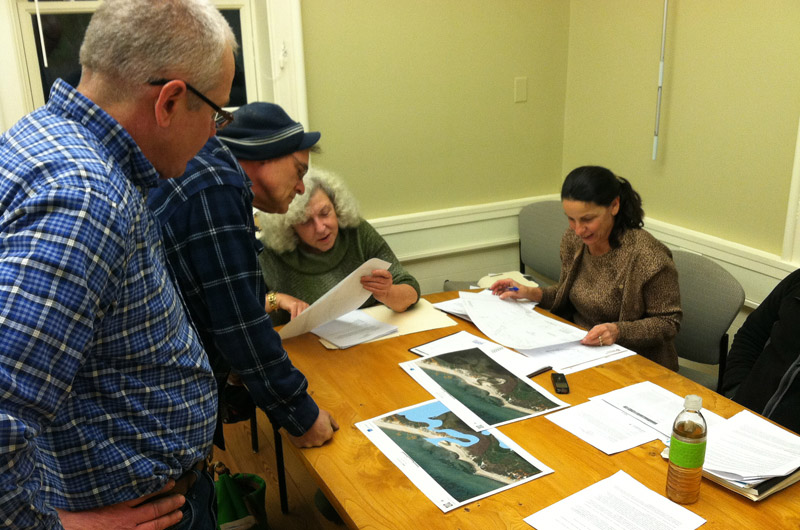With support from the state Division of Marine Fisheries and the West Tisbury conservation commission, a group of residents will once again get out their shovels and widen a channel between James Pond and Vineyard Sound to allow the passage of herring and other species that spawn in inshore waters.
Town herring warden Johnny Hoy has petitioned the state to allow the openings, which have happened mostly under the radar since the 1980s. The town is now working with the DMF to develop a longer-term maintenance plan that would allow the use of heavy machinery to clear the channel, and may entail annual water quality monitoring.
At a public hearing on Tuesday, the conservation commission met with Mr. Hoy and DMF marine fisheries biologist Brad Chase to review the draft plan, which includes removing sediment from the winding channel and depositing it along the banks. Salt marsh plantings would help stabilize the area, and fiber rolls may be added in the future.
Mr. Chase believed the openings should happen with or without water quality monitoring, given the importance of the fish passage, which has narrowed as a result of storms and other causes. Mr. Hoy has pointed out that private jetties built around the 1950s have caused sand to collect along the shore.
A wider channel would benefit eels, white perch, herring and possibly shellfish, Mr. Chase said, although it was unclear how abundant white perch are anymore in the pond.
“The key thing is that we need to commit to some type of active maintenance,” he said, noting that the alternatives were to continue hand digging each year, build a permanent structure to maintain the inlet, or ignore the problem altogether. “You are never going to stop mother nature,” he added. “But it might give us some some stability for a few years.”
The hearing was continued to March 22 so the commission could hear from the Department of Environmental Protection and the Natural Heritage and Endangered Species Program. (The entire project area and most of the 50-acre pond is habitat for state-listed rare species.) The commission also plans to hear a report from Greg Berman of the Woods Hole Oceanographic Institution.
But the manual digging will need to happen in the next three weeks to avoid the arrival of fish and eels in the pond. No work is allowed in the pond between March 15 and June 30, or between Sept. 1 and Nov. 15, to allow for migration.
Commissioners unanimously approved a motion allowing the hand-digging to continue this year and as needed, with prior notification to the DMF. They also discussed altering the maintenance plan to allow for manual clearing in emergencies, such as after a storm. Mr. Hoy noted that the channel constantly changes with the tides and weather. “We need to be responding to what’s happening,” he said.
Mr. Chase agreed, adding that in the case of a heavy storm, the DMF would typically defer to the herring warden to clear the channel. “Our agency would want them to react,” he said.
Accessing the channel with heavy equipment will likely require the cooperation of landowners near the pond. Conservation agent Maria McFarland noted that the primary work would occur in state waters, but she stressed the need to restore the area afterwards. Commissioner Whit Griswold, who lives near the pond, had sent a letter to abutters explaining the project. All but one replied, he said, and those who did were onboard.
The question of access will likely depend on what type of equipment the town uses. Mr. Chase suggested renting an excavator large enough to do the job and not get stuck in the sand.
Monitoring would be a local effort, but Mr. Chase offered to provide some of the equipment free of charge. Commissioner Prudy Burt suggested working with Bret Stearns, natural resources director for the Wampanoag Tribe of Gay Head (Aquinnah), who has offered his assistance. The commission also plans to reach out to the Martha’s Vineyard Commission for guidance.
Mr. Chase strongly supported the efforts to widen the channel and monitor the pond, in part because they could apply to other ponds in the area. “It would be useful to learn from this case,” he said.








Comments (8)
Comments
Comment policy »